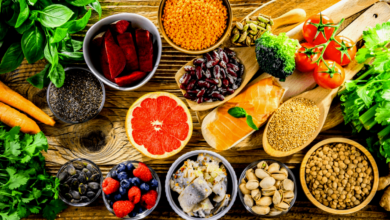How to Read U.S. Food Labels Like a Nutritionist
How to read U.S. food labels like a nutritionist Learn to decode serving sizes ingredients and nutrients for smarter healthier food choices.

Understanding how to read U.S. food labels like a nutritionist is the key to making smarter, healthier food choices. Every packaged product in the grocery store comes with a Nutrition Facts panel, but without the right knowledge, it’s easy to be misled by marketing claims, confusing serving sizes, and hidden ingredients. By learning to decode these labels effectively, you can identify unnecessary additives, avoid excessive sugar and unhealthy fats, and select foods that truly support your well-being.
Navigating food labels doesn’t have to be overwhelming. With a few expert strategies, you can quickly assess whether a product aligns with your dietary needs. This guide will break down each section of a U.S. food label from serving sizes and percent daily values to ingredient lists and health claims so you can shop with confidence. Whether you’re managing a health condition, optimizing your diet, or simply aiming for cleaner eating, mastering how to read U.S. food labels like a nutritionist will empower you to take control of your nutrition.
How to Read U.S. Food Labels Like a Nutritionist
Serving Size, The Foundation of Label Reading
The serving size is the first and most crucial element on the Nutrition Facts panel, as all other values are based on this measurement. Many consumers mistakenly assume that the entire package equals one serving, leading to accidental overconsumption of calories, sugar, or sodium. For example, a small bag of chips may list 150 calories per serving but contain 2.5 servings per bag meaning eating the whole bag actually provides 375 calories. Always check the serving size first to accurately assess your Food Labels .
Calories and Macronutrients Understanding the Big Picture
While calories indicate energy content, they don’t reveal nutritional quality. The label breaks down macronutrients Fats Includes total fat, saturated fat, and trans-fat. Limit saturated and avoid trans fats for heart health. Carbohydrates Covers total carbs, dietary fiber (aim for high fiber), and sugars (watch for added sugars). Protein Essential for muscle repair, but Food Labels Americans already consume enough. These components help you balance your diet for instance, choosing foods higher in fiber and protein for satiety and lower in added sugars for metabolic health.
Micronutrients and % Daily Value (DV) Spotting Nutrient Density
The label lists key micronutrients like vitamin D, calcium, iron, and potassium, along with their % Daily Value (DV). This percentage shows how much a serving contributes to your daily needs 5% DV or less = Low (e.g., sodium in processed foods). 20% DV or more = High (ideal for fiber, vitamins, and minerals). For example, a cereal with 25% DV for iron is a good source, while one with 5% DV for calcium may not be. Use this to prioritize nutrient-rich foods and limit less healthy components.
Decoding Macronutrients and Micronutrients
Fats, Cholesterol & Sodium Understanding the Risks
The fat section reveals crucial health information unsaturated fats (mono- and polyunsaturated) from sources like avocados and fish support heart health, while saturated fats (found in animal products) should be limited to <10% of daily calories. Trans fats (listed as “partially hydrogenated oils”) are particularly harmful and should be avoided entirely. Cholesterol intake matters for Food Labels with heart concerns, and sodium should be limited to <2,300mg daily (about 1 tsp salt) to maintain healthy blood pressure. Nutritionists recommend comparing products to choose options with healthier fat profiles and lower sodium content.
Carbs, Protein & Micronutrients The Quality Matters
The carbohydrates section now clearly separates natural sugars (inherent in foods like fruit and milk) from added sugars (which should be limited to <10% of daily calories). Fiber intake (aim for 25-30g daily) is crucial for gut health and blood sugar control. While protein is listed, most Americans meet requirements easily. The micronutrient section (%DV) helps identify nutrient-dense foods: prioritize items with 20%+ DV for vitamins/minerals like iron, calcium and potassium, Food Labels minimizing those high in added sugars and sodium. This approach helps select foods that provide maximum nutritional benefit per calorie.
Ingredient Lists and Hidden Additives
Beyond the Nutrition Facts panel, the ingredient list is where you’ll uncover the true composition of a product. Ingredients are listed in descending order by weight, meaning the first few items make up the bulk of the food. A good rule of thumb is to choose products with shorter ingredient lists and recognizable whole foods rather than chemical additives. Watch out for hidden Food Labels, which may appear under names like high-fructose corn syrup, maltose, or dextrose. Similarly, artificial preservatives, colors, and flavor enhancers (such as MSG) can indicate a highly processed item.
Common Label Claims and Their Meanings
Food packaging often features claims like “organic,” “natural,” or “low-fat,” but these terms can be misleading. For instance, Organic means the product meets USDA organic standards, but it doesn’t automatically make it healthy (organic sugar is still sugar). Natural has no strict FDA definition, so it’s largely a marketing term. Low-fat or “reduced fat” products often compensate with added sugars or artificial thickeners. Gluten-free is essential for those with celiac disease but unnecessary for others unless choosing whole, naturally gluten-free foods. Understanding these claims helps you avoid Food Labels for deceptive marketing and instead focus on the actual nutritional content.
Practical Tips for Smart Label Reading
To truly master how to read U.S. food labels like a nutritionist, adopt these expert strategies Compare similar products Check labels of different brands to choose the one with lower sodium, fewer additives, or higher fiber. Prioritize whole foods Minimally processed items typically have simpler ingredient lists and better nutrient profiles. Be wary of “health halos” Foods labeled as “vegan,” “non-GMO,” or “keto” aren’t automatically nutritious. Use the 5% and 20% rule Aim for higher DVs in fiber, vitamins, and minerals, and lower DVs in saturated fat, sodium, and added sugars. Check serving Food Labels first Avoid underestimating how much you’re actually consuming.
Read More: How Climate Change Is Affecting Health in the U.S. What You Can Do
Conclusion
Mastering how to read U.S. food labels like a nutritionist is one of the most valuable skills you can develop for lifelong health. By understanding serving sizes, decoding ingredient lists, and interpreting nutrient percentages, you gain the power to make informed choices that align with your wellness goals. Food manufacturers often use clever marketing tactics to make products appear healthier than they are, but with this knowledge, you can see past the hype and select truly nourishing options.
Ultimately, the best nutritional strategy combines label-reading skills with a focus on whole, minimally processed foods. While packaged items can fit into a balanced diet, fresh fruits, vegetables, lean proteins, and whole grains should always form the Food Labels. As you continue practicing how to read U.S. food labels like a nutritionist, you’ll find it becomes second nature transforming your grocery trips into opportunities for better health, one smart decision at a time.
FAQs
What’s the most important part of a food label?
The serving size and calories are critical, but the ingredient list reveals the quality of the food. Always check these first.
How can I spot hidden sugars?
Look for terms like sucrose, fructose, malt syrup, or anything ending in “-ose” in the ingredient list.
Are “low-fat” products healthier?
Not always they often contain added sugars or artificial ingredients to compensate for reduced fat.
Why do some foods have high %DV for sodium?
Processed foods often contain excessive sodium for preservation and flavor, which can contribute to high blood pressure.
Do I need to track every nutrient?
Focus on key areas like fiber, protein, added sugars, and unhealthy fats based on your personal health goals.










